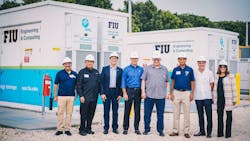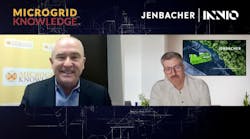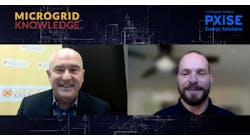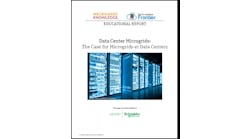When AI Predicts Grid Trouble, Microgrid Creates a Smart City at a Florida University
At Florida International University (FIU), researchers are utilizing artificial intelligence (AI) as an important tool that creates new ways for microgrids to provides resilience, cut carbon emissions, and aid the grid when it's stressed.
At the university, a microgrid that serves the engineering campus is also enabling long-term research utilizing a 1MW system that mimics the buildings on the engineering campus that have a peak load profile of roughly 1 MW.
In ongoing research, the system uses AI to determine when the grid may be faltering. Then – ahead of an outage - the AI islands the microgrid and creates a smart city in which the buildings on the engineering campus continue to be powered.
"The whole engineering campus operates like an independent city, complete by itself with its own generation and storage continuing to deliver electricity to 10,000 students and faculty members on the university’s engineering campus," said Alexander Stevenson, graduate research assistant and lab coordinator for FIU's Energy, Power and Sustainability Group.
Energy resilience important with high heat, hurricanes and thunderstorms
This type of resilience can be especially helpful in Florida, which experiences high heat, occasional hurricanes and frequent thunderstorms that can destabilize the grid.
The microgrid is a joint project between FIU and Florida Power & Light Company (FPL), which invested $15.5 million to build the lab at the FIU-FPL Solar Research Center where the microgrid research is taking place.
FPL installed the microgrid to conduct research at FIU in 2020, and is continuing to make modifications to it to provide additional benefits to the research buildings and learn about the technology.
The research has generated much interest, especially from federal agencies, said Arif Sarwat, a professor in FIU's department of electrical and computer engineering and the director of the FIU-FPL Solar Research Center.
Federal agencies following FIU's progress
"Our control room is visited almost every week by agencies. The government is very high on microgrids," he said. What's most unique about this "next-generation microgrid" is how it utilizes AI, Sarwat said.
AI decides how the microgrid will be deployed. However, in most microgrids, AI is used as a secondary function, not to control a microgrid, he explained.
The FPL/FIU microgrid can use many different kinds of fuel sources, including renewable energy, diesel and potentially hydrogen in the future.
"This is the first microgrid that has used AI for control and operations," said Sarwat. "Others use it for secondary processes, not in the main line of operations. The others use basic logic: if-then scenarios."
Forecasting clouds over solar panels
As part of its work in the microgrid, AI forecasts weather and load conditions, as well as power costs, and then tells the microgrid how to function - both in the short term - and long term, he said.
For example, AI can predict whether the region will be cloudy a few days ahead to ensure the batteries are filled with solar power before the clouds arrive. Another microgrid innovation at FIU: The main inverter is a grid-forming inverter. "Most microgrids don't have this technology," said Sarwat. "We are the first to use a grid-forming inverter at this level."
Grid-forming inverters allow solar and other inverter-based energy sources to restart the microgrid independently, which is also known as a black start. Generally, after an outage, conventional - or grid-following - inverters shut off power and wait for signals from the rest of the grid to restart.
Duke Energy created an inverter-based community microgrid that is capable of black start. Running only on solar and batteries, the community microgrid can restart following a power outage without help from a fossil fuel generator or the electric grid.
At FIU, the grid-forming inverter allows the microgrid to be the leader, rather than the follower, said Sarwat.
"All the solar panels and inverters are grid following. The grid-forming inverter allows this microgrid to be independent of the utility."
A modular microgrid
The FIU microgrid is also designed to be modular so it can be delivered on a truck to its final interconnection location. This will make it easier for other organizations and businesses to deploy the microgrid. It includes two 4.5-MWh storage units, and power comes from 4,400 solar panels - generating about 1.4 MW - located at the research center.
While the total load of the engineering buildings is about 1 MW, the system is oversized in part to demonstrate that the microgrid can be scaled and that it can be used in other applications, said Sarwat. It's also oversized to provide grid services, such as peak shaving, to FPL.
The university has chillers that experience peaks on hot days when air conditioning is needed. "The chiller will peak on and put load on the grid," said Stevenson. "We can operate the battery to shave the campus' peak and reduce the load on the grid." The system can also provide frequency regulation, and the researchers are studying other ways it can provide grid services.
The microgrid can island for nine hours to serve the two engineering buildings, or for 24 hours if only serving critical circuits.
Other universities advance microgrids
A number of other universities are also working to advance microgrids. The University of St. Thomas Center for Microgrid Research began researching microgrids in 2014 when its School of Engineering was awarded a $1.5 million grant from Xcel Energy's Renewable Development Fund to build a microgrid research and test center.
At the time, the Center for Microgrid Research was focused on providing real-world education for undergraduate and graduate students interested in microgrids. Now it's addressing as many microgrid challenges as possible - as well as providing hands-on education to students.
The center is also working with the U.S. Department of Defense and other branches of the military to reach a goal of deploying a microgrid at every facility by 2035.
In addition, the Schatz Energy Research Center at Humboldt State University designed the Redwood Coast Airport Microgrid - California's first 100% renewable, front-of-the-meter microgrid.
Not only do university research efforts benefit the universities where the work is done, but, like the Redwood Coast example, the researchers help boost resilience and the use of renewable energy outside the university setting.
"This design was not only done for the benefit of our research," said Sarwat. "It was done so it could be replicated across America."








